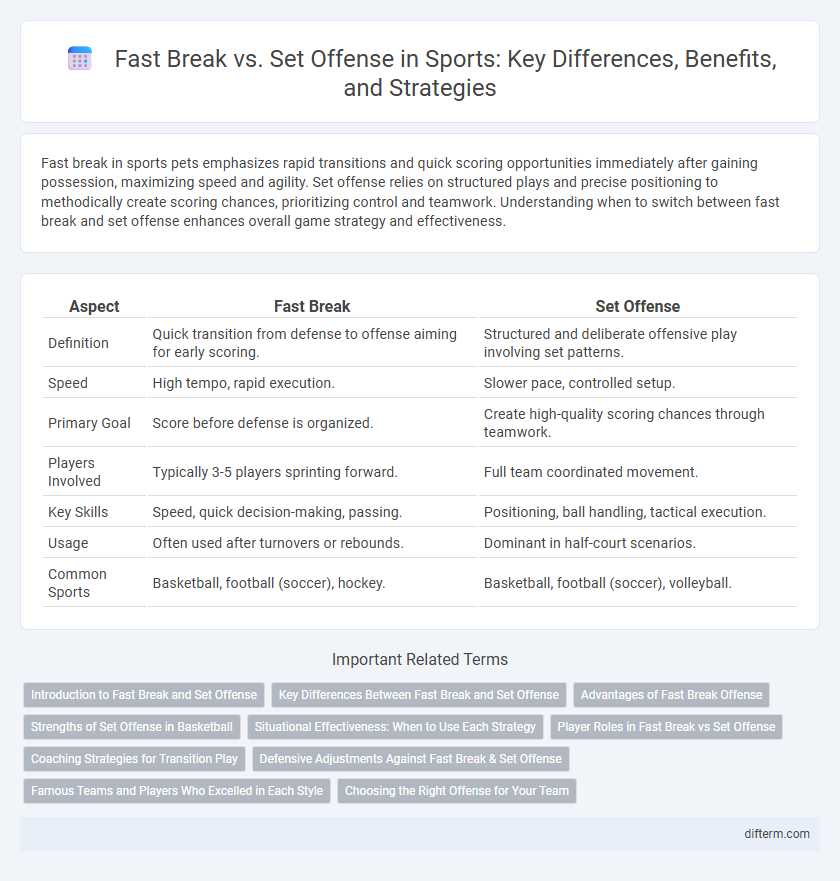Fast break in sports pets emphasizes rapid transitions and quick scoring opportunities immediately after gaining possession, maximizing speed and agility. Set offense relies on structured plays and precise positioning to methodically create scoring chances, prioritizing control and teamwork. Understanding when to switch between fast break and set offense enhances overall game strategy and effectiveness.
Table of Comparison
| Aspect | Fast Break | Set Offense |
|---|---|---|
| Definition | Quick transition from defense to offense aiming for early scoring. | Structured and deliberate offensive play involving set patterns. |
| Speed | High tempo, rapid execution. | Slower pace, controlled setup. |
| Primary Goal | Score before defense is organized. | Create high-quality scoring chances through teamwork. |
| Players Involved | Typically 3-5 players sprinting forward. | Full team coordinated movement. |
| Key Skills | Speed, quick decision-making, passing. | Positioning, ball handling, tactical execution. |
| Usage | Often used after turnovers or rebounds. | Dominant in half-court scenarios. |
| Common Sports | Basketball, football (soccer), hockey. | Basketball, football (soccer), volleyball. |
Introduction to Fast Break and Set Offense
Fast break is a high-speed offensive strategy in basketball that emphasizes quick transitions from defense to attack, aiming to score before the opposing defense can set up. Set offense involves organized plays and positioning, relying on ball movement and player spacing to create scoring opportunities within a structured half-court scenario. Understanding the distinction between fast break and set offense is crucial for optimizing team performance and adapting to different game situations.
Key Differences Between Fast Break and Set Offense
Fast break in sports is characterized by rapid transitions and quick scoring attempts immediately after gaining possession, emphasizing speed and exploiting defensive gaps. Set offense, in contrast, involves structured plays and strategic ball movement designed to create high-percentage scoring opportunities against organized defenses. Key differences include pace of play, decision-making urgency, and reliance on pre-planned tactics versus spontaneous execution.
Advantages of Fast Break Offense
Fast break offense maximizes scoring opportunities by exploiting defensive transitions before the opposing team can set up, increasing game pace and pressure. It emphasizes speed, quick decision-making, and athleticism, often leading to higher point totals and momentum shifts. This strategy reduces the risk of turnovers and forces defenses to react, creating open lanes and easier shot selections.
Strengths of Set Offense in Basketball
Set offense in basketball excels at structured, deliberate play that maximizes scoring efficiency through strategic ball movement and precise positioning. It allows teams to exploit defensive weaknesses by creating high-percentage shooting opportunities, such as open mid-range jumpers or post plays. Controlled tempo during set offense reduces turnovers and fosters disciplined execution, enhancing overall team performance.
Situational Effectiveness: When to Use Each Strategy
Fast break is most effective during transitional moments when the opposing defense is unsettled, allowing teams to capitalize on speed and quick decision-making for high-percentage scoring opportunities. Set offense excels in half-court scenarios, relying on structured plays and precise ball movement to exploit defensive weaknesses and create open shots. Coaches often choose fast break to exploit late rotations and set offense to maintain control and execute deliberate scoring tactics.
Player Roles in Fast Break vs Set Offense
In fast break scenarios, players prioritize speed and quick decision-making, with guards leading the transition push and wings filling lanes for easy scoring opportunities. Set offenses emphasize structured roles, where point guards orchestrate plays, centers establish screens, and forwards create spacing and spot-up shooting options. Each role adapts to maximize efficiency, with fast breaks relying on agility and immediacy, while set offenses depend on discipline and positional awareness.
Coaching Strategies for Transition Play
Coaching strategies for transition play emphasize quick decision-making and spacing during fast breaks to exploit numerical advantages before the defense sets up. In contrast, set offense coaching prioritizes structured plays, precise timing, and player positioning to create high-percentage scoring opportunities against organized defenses. Effective coaches develop drills that enhance players' reaction speed and court awareness for fast breaks while reinforcing disciplined execution and role comprehension in set offenses.
Defensive Adjustments Against Fast Break & Set Offense
Defensive adjustments against a fast break prioritize quick transition defense, emphasizing rapid communication, sprinting back to establish perimeter spacing, and forcing the ball handler toward the sidelines to limit passing options. In contrast, defending a set offense requires structured team rotations, strong help defense, and strategic positioning to disrupt offensive plays, control the paint, and contest perimeter shots effectively. Mastery of these defensive tactics improves turnover rates and reduces high-percentage scoring opportunities for opponents across various levels of basketball competition.
Famous Teams and Players Who Excelled in Each Style
The Los Angeles Lakers and Golden State Warriors are renowned for their mastery of the fast break, with players like Magic Johnson and Stephen Curry excelling in rapid transitions and quick scoring opportunities. In contrast, the San Antonio Spurs, led by Tim Duncan and coached by Gregg Popovich, epitomize set offense through methodical ball movement and strategic plays. These teams showcase how distinct playing styles leverage player strengths to dominate in professional basketball.
Choosing the Right Offense for Your Team
Selecting the right offense depends on your team's strengths and pace, as fast break exploits speed and transition opportunities to score quickly, while set offense emphasizes structured plays and precise execution. Teams with athletic, quick players thrive in fast break strategies, maximizing open-court opportunities and forcing defensive mismatches. In contrast, squads with skilled shooters and disciplined ball handlers benefit from set offense by creating high-percentage shots through coordinated movement and spacing.
Fast Break vs Set Offense Infographic

 difterm.com
difterm.com